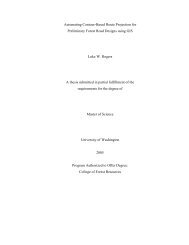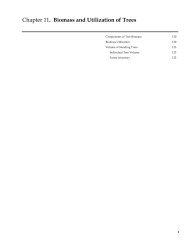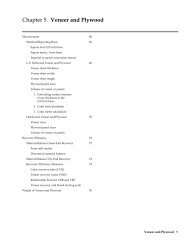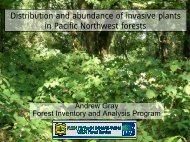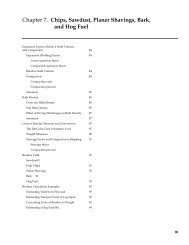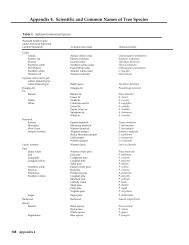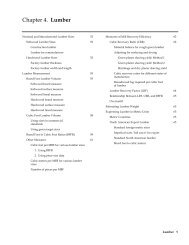Chapter 8. Pulp and Paper
Chapter 8. Pulp and Paper
Chapter 8. Pulp and Paper
You also want an ePaper? Increase the reach of your titles
YUMPU automatically turns print PDFs into web optimized ePapers that Google loves.
<strong>Chapter</strong> <strong>8.</strong> <strong>Pulp</strong> <strong>and</strong> <strong>Paper</strong><br />
<strong>Pulp</strong> Yield 96<br />
Mechanical <strong>Pulp</strong>ing 96<br />
Chemical <strong>Pulp</strong>ing 96<br />
Kraft (sulfate) process<br />
Sulfite process<br />
Hybrid <strong>Pulp</strong>ing Methods 97<br />
Dissolving <strong>Pulp</strong> 97<br />
Estimating Wood Required per Ton of <strong>Pulp</strong> 97<br />
<strong>Paper</strong> <strong>and</strong> <strong>Paper</strong>board 99<br />
Basis Weight <strong>and</strong> Grammage 99<br />
Basis weight<br />
Grammage<br />
Thickness (Caliper) 99<br />
Density <strong>and</strong> Bulk 100<br />
<strong>Pulp</strong> <strong>and</strong> <strong>Paper</strong> 1
<strong>Chapter</strong> <strong>8.</strong> <strong>Pulp</strong> <strong>and</strong> <strong>Paper</strong><br />
<strong>Pulp</strong> is the fibrous mass that results when<br />
a pulping process ruptures the bonds in the wood<br />
structure that hold the woody cells together.<br />
<strong>Pulp</strong>ing is done mechanically, thermomechanically,<br />
chemically, or with combinations of these<br />
treatments. Commercial processes are generally<br />
classified as mechanical, chemical, or semichemical—the<br />
latter being various combinations<br />
of chemical <strong>and</strong> mechanical. Appendix 2, Section<br />
G, shows that 82% of 1986 production was chemical<br />
pulping, of which 91% is produced by the kraft<br />
(sulfate) process. Semichemical pulping accounts for<br />
about 7% of production, <strong>and</strong> various mechanical<br />
pulping processes account for the remainder.<br />
<strong>Pulp</strong> statistics are usually reported in units of<br />
weight. The most common are<br />
short ton = 2,000 lb = 907 kg<br />
metric tonne = 1,000 kg = 2,204 lb.<br />
<strong>Pulp</strong> is generally reported as an air-dried<br />
product that is assumed to be 10% water <strong>and</strong> 90%<br />
oven-dry pulp. The actual condition of a shipment<br />
may vary somewhat from this definition. <strong>Pulp</strong> is<br />
commonly sold in bales (32 x 32 x 15 inches) which<br />
weigh about 500 pounds.<br />
2 <strong>Chapter</strong> 8<br />
<strong>Pulp</strong> Yield<br />
Recovery from pulping wood is commonly<br />
expressed as the percentage, by oven-dry weight, of<br />
pulp obtained from the original wood weight.<br />
A recovery value of 45% means that for every 100<br />
oven-dry pounds of wood processed, 45 oven-dry<br />
pounds of pulp is produced. When expressed in this<br />
manner, pulp yield is mainly a function of the pulping<br />
process. There is some difference between hardwoods<br />
<strong>and</strong> softwoods when pulped by chemical<br />
processes, due to the difference in chemical make-<br />
up between these groups. Table 8-1 provides a<br />
summary of common pulping processes <strong>and</strong> yields.<br />
Section G of Appendix 2 shows percentage use of<br />
hardwood <strong>and</strong> softwood species.<br />
Mechanical <strong>Pulp</strong>ing<br />
The earliest <strong>and</strong> one of the most common<br />
mechanical pulping methods is the groundwood<br />
process, in which a roundwood bolt is pressed<br />
lengthwise against a rough, revolving grinding<br />
stone. The wood fibers are torn out of the wood,<br />
abraded, <strong>and</strong> removed from the stone surface with<br />
water. A different process, called refiner mechan- ical<br />
pulp (RMP) utilizes chips, which are shredded into<br />
fibers between large rotating disks of a device called<br />
a refiner. The basic RMP process has evolved to<br />
employ thermal <strong>and</strong>/or chemical presoftening of the<br />
chips, which reduces energy use <strong>and</strong> modifies<br />
resultant pulp properties; this is typically termed<br />
thermomechanical pulp (TMP).<br />
Mechanical pulping has the advantage of<br />
converting up to 95% of the dry weight of the wood<br />
input into pulp, but the mechanical action requires a<br />
large energy input. The pulp forms a highly opaque<br />
paper with good printing properties, but the paper<br />
is relatively weak <strong>and</strong> discolors easily with exposure<br />
to light. Newsprint is a major product of mechanical<br />
pulp. Mechanical pulps are generally produced<br />
from long-fibered softwood (conifer) species. The<br />
smaller, thinner fibers from hardwoods are more<br />
severely damaged by the mechanical action, hence<br />
yield a weaker paper. However, some hardwoods,<br />
such as poplar, which produces very bright pulp,<br />
are mechanically pulped <strong>and</strong> blended with<br />
softwood mechanical pulps to improve optical<br />
properties.<br />
Chemical <strong>Pulp</strong>ing<br />
In chemical pulping, the fibers in wood are<br />
separated by dissolving away the lignin component,<br />
leaving behind a fiber that retains most<br />
of its cellulose <strong>and</strong> some hemicellulose. Yields of<br />
chemical processes are on the order of 40 to 50%<br />
of the dry weight of the original wood input.<br />
Kraft (Sulfate) Process. Because of advantages<br />
in chemical recovery <strong>and</strong> pulp strength, the kraft<br />
process dominates the industry. It represents 91% of<br />
chemical pulping <strong>and</strong> 75% of all pulp (Appendix 2,<br />
Section G). It evolved from an earlier soda process<br />
(using only sodium hydroxide as the active chemical)<br />
<strong>and</strong> adds sodium sulfide to the cooking<br />
chemical formulation. This is the process associated<br />
with the foul odor problem in the environment. A<br />
number of pulp grades are commonly produced,<br />
<strong>and</strong> the yield depends on the grade of product.<br />
Unbleached pulp grades, characterized
y a dark brown color, are generally used for<br />
packaging products <strong>and</strong> are cooked to a higher yield<br />
<strong>and</strong> retain more of the original lignin. Bleached pulp<br />
grades are made into white papers. Figure 8-1<br />
shows a pulping curve <strong>and</strong> relationship between<br />
yield, kappa number, <strong>and</strong> corresponding product.<br />
Nearly half of the kraft production is in bleached<br />
grades, which have the lowest yields. In Figure 8-1,<br />
kappa number refers to the result of a test of the<br />
amount of residual lignin in the pulp—lower kappa<br />
meaning less lignin. Effective alkali <strong>and</strong> sulfidity<br />
refer to conditions of certain key chemical aspects of<br />
the process (for details see Smook 1992). Curves<br />
such as shown in Figure 8-1 also differ with wood<br />
species.<br />
Figure 8-1. Kraft pulp yield vs. kappa <strong>and</strong> effective alkali<br />
charge. Source: Smook (1992).<br />
Sulfite Process. This process uses different<br />
chemicals to attack <strong>and</strong> remove lignin. Compared to<br />
kraft pulps, sulfite pulps are brighter <strong>and</strong> bleach<br />
more easily, but are weaker. Sulfite pulps are<br />
produced in several grades but bleached grades<br />
dominate production. Yields are generally in the<br />
range of 40 to 50%, but tend toward the lower end of<br />
this range in bleached grades. Compared to the kraft<br />
process, this operation has the disadvantage of<br />
being more sensitive to species characteristics. The<br />
sulfite process is usually intolerant of resinous<br />
softwoods, tannin-containing hardwoods, <strong>and</strong> any<br />
furnish containing bark.<br />
Hybrid <strong>Pulp</strong>ing Methods<br />
A number of processes are hybrids of chemical<br />
<strong>and</strong> mechanical methods <strong>and</strong> have intermediate<br />
yields. Generally, chips are partly softened or<br />
digested with chemicals <strong>and</strong> then are mechanically<br />
converted to fiber, usually in disk refiners.<br />
Chemimechanical pulping, typically used on<br />
hardwoods, softens chips prior to usual mechanical<br />
action <strong>and</strong> has yields in the 80 to 90% range. Semichemical<br />
pulping involves greater cooking <strong>and</strong><br />
delignification prior to mechanical refining; yields<br />
are somewhat lower, depending on the degree of<br />
cooking.<br />
Dissolving <strong>Pulp</strong><br />
Dissolving pulps are specialty pulps used for<br />
chemical conversion into products such as rayon,<br />
cellophane, <strong>and</strong> cellulose acetate. These pulps can be<br />
made by either a modified kraft (prehydrolysis) or<br />
sulfite process in which the aim is to obtain a pulp<br />
of pure cellulose. Since essentially all lignin <strong>and</strong><br />
hemicellulose are removed, dissolving pulps have<br />
the lowest yields, on the order of 35%.<br />
Estimating Wood Required<br />
per Ton of <strong>Pulp</strong><br />
It is also common to express pulp yield as airdry<br />
or oven-dry tons of pulp per cord or other unit<br />
of wood volume. Alternatively, the reciprocal of<br />
these measures indicates the number of cords or<br />
other wood unit required per ton of pulp. In<br />
addition to the factors discussed above, these<br />
measures are affected by wood density. Yield is<br />
generally higher (less wood is required) for denser<br />
species.<br />
To estimate wood required per ton of pulp, the<br />
following information is needed: (1) moisture<br />
content of pulp, (2) pulp yield, <strong>and</strong> (3) specific<br />
gravity of the species used as raw material.<br />
There are several variations in calculating wood<br />
requirements, due to the different measures<br />
of pulp (short ton, metric tonne) <strong>and</strong> different<br />
measures for the wood raw material (cubic foot,<br />
cubic meter, bone-dry unit). A bone-dry unit (BDU)<br />
represents 2,400 pounds of chips or residues. See<br />
<strong>Chapter</strong> 7 for further discussion of chip <strong>and</strong> residue<br />
measures <strong>and</strong> conversions. Basic formulas are:<br />
<strong>Pulp</strong> <strong>and</strong> <strong>Paper</strong> 3
Example 1<br />
How many cubic feet of solid western hemlock wood<br />
are needed to produce one short ton (2,000 lb) of<br />
oven-dry bleached kraft pulp (kappa 30)?<br />
Formula 1 gives 10 = [(2,000 lb – DP) / 2,000 lb] * 100<br />
solving: DP = 1,800 lb of oven-dry fiber per ton of pulp.<br />
Formula 2 gives 45 = (1,800 lb / DW) * 100<br />
solving: DW = 4,000 lb oven-dry wood per ton of pulp.<br />
Here the yield of bleached kraft pulp is assumed to be<br />
45% (Figure 8-1).<br />
Formula 3 gives 4,000 lb = V * 0.42 * 62.4 lb/ft 3<br />
solving: V = 153 cubic feet of green wood per ton of<br />
pulp.<br />
Here 0.42 is the specific gravity of western hemlock<br />
(Table 1-1).<br />
Example 2<br />
How many cubic meters of solid western hemlock<br />
wood are needed to produce one tonne (1,000 kg) of<br />
oven-dry bleached kraft pulp (kappa 30)?<br />
Formula 1 gives 10 = [(1,000 kg – DP) / 1,000 kg] * 100<br />
solving: DP = 900 kg of oven-dry fiber per tonne of<br />
pulp.<br />
Formula 2 gives 45 = (900 kg / DW) * 100<br />
solving: DW = 2,000 kg oven-dry wood per tonne of<br />
pulp.<br />
Here the yield of bleached kraft pulp is assumed to be<br />
45% (Figure 8-1).<br />
Formula 3 gives 2,000 kg = V * 0.42 * 1,000 kg/m3 solving: V = 4.76 cubic meters of green wood per<br />
tonne of pulp.<br />
Here 0.45 is the specific gravity of western hemlock<br />
(Table 1-1).<br />
Example 3<br />
How many cords of western hemlock wood are<br />
needed to produce one short ton of oven-dry bleached<br />
kraft pulp?<br />
Example 1 found that 153 cubic feet of solid green wood<br />
are needed per ton of bleached Douglas-fir kraft pulp.<br />
Assuming a cord contains 80 cubic feet of solid wood<br />
(<strong>Chapter</strong> 3), this is equivalent to 1.91 cords/ton.<br />
4 <strong>Chapter</strong> 8<br />
Example 4<br />
How many cubic feet of gravity-packed western<br />
hemlock chips are needed to produce one short ton<br />
(2,000 lb) of oven-dry bleached kraft pulp?<br />
To answer this question, one must know the relationship<br />
between wood volume before <strong>and</strong> after chipping. This<br />
depends on chip geometry, degree of settling <strong>and</strong><br />
compaction, <strong>and</strong> so forth, which are discussed in <strong>Chapter</strong><br />
7. In this example it is assumed that chips occupy 2.5<br />
times the original solid wood volume (see Table 7-1).<br />
Example 1 found that 153 cubic feet of solid western<br />
hemlock wood were needed to produce a ton of pulp. The<br />
equivalent amount of chips is 2.5 times greater, or 382.5<br />
cubic feet.<br />
Example 5<br />
How many "units" of western hemlock chips are<br />
needed to produce a ton of oven-dry bleached kraft<br />
pulp?<br />
A "unit" typically refers to a 200 cubic foot container.<br />
Example 4 found that a ton of bleached kraft pulp requires<br />
382.5 cubic feet of western hemlock chips. Division by 200<br />
reveals that this is equivalent to 1.91 units.<br />
Example 6<br />
How many bone-dry units (BDU) of chips are needed<br />
to produce an oven-dry ton of pulp?<br />
Example 1 found that 4,000 pounds of oven-dry wood are<br />
needed per ton of pulp. Since one BDU equals 2,400<br />
pounds of oven-dry wood, the answer is<br />
(4,000 lb/ton pulp) / (2,400 lb/BDU) = 1.67 BDU/ton<br />
pulp.<br />
Example 7<br />
How many bone-dry units (BDU) are needed to<br />
produce an oven-dry tonne of pulp?<br />
Multiply the result from Example 6 by<br />
(2,204 lb/tonne) / (2,000 lb/ton) = 1.102 ton/tonne.<br />
Hence, 1.67 BDU/ton * 1.102 ton/tonne = 1.84<br />
BDU/tonne.
Formula 1. MCw = [(WP – DP) / WP] * 100<br />
MCw = pulp moisture content on total<br />
weight basis (%)<br />
WP = pulp weight including moisture<br />
DP = oven-dry weight of pulp<br />
Formula 2. Y = (DP / DW) * 100<br />
Y = pulp yield (%)<br />
DW = oven-dry weight, wood raw material<br />
Formula 3. DW = V * SGg * F<br />
V = green volume of wood raw material<br />
SGg = wood specific gravity (see Table 1-1)<br />
F = density of water = 62.4 lb/ft3 or<br />
1,000 kg/m3 In Examples 1 through 7 the pulp moisture<br />
content is assumed to be 10%. These examples<br />
illustrate both the information needed <strong>and</strong><br />
computational steps involved in developing the<br />
common conversion factors of interest. The reader<br />
can substitute yields for other processes, specific<br />
gravities for other species, <strong>and</strong> other pulp moisture<br />
contents.<br />
Appendix 2, Section G, presents overall average<br />
values of wood consumption in manufacturing pulp<br />
in 1986. It should also be noted that about 31% of the<br />
solid pulpwood used is actually<br />
in the form of residue by-products from other wood<br />
industries (Haynes 1990).<br />
<strong>Paper</strong> <strong>and</strong> <strong>Paper</strong>board<br />
When paper <strong>and</strong> paperboard are produced,<br />
converted, <strong>and</strong> sold, several measurements are<br />
important. This section briefly discusses them <strong>and</strong><br />
provides some illustrative data. Industry statistics<br />
are usually reported on a weight basis, <strong>and</strong> the<br />
st<strong>and</strong>ard weight conversions found in Appendix 1<br />
can be used.<br />
Basis Weight <strong>and</strong> Grammage<br />
When paper <strong>and</strong> paperboard are produced <strong>and</strong><br />
converted, two key characteristics are weight <strong>and</strong><br />
area. Production is generally reported in tons, <strong>and</strong><br />
products are sold on either a weight or an area basis<br />
depending on the needs of the customer.<br />
Basis Weight. The common measure in the<br />
United States, basis weight, is "the weight, in pounds,<br />
of a predetermined number of sheets having a<br />
specific size" (Scott 1989). The predetermined<br />
number of sheets is the ream. Generally 500 sheets<br />
form a ream, but a ream contains 480 sheets for<br />
some products. Since various producers <strong>and</strong><br />
converters need different size sheets, a variety of<br />
basic sizes have evolved over time. Table 8-2<br />
indicates basic size <strong>and</strong> basis weights for several<br />
grades (500 sheet ream). For example, cover papers<br />
have basis weights of 40, 50, 60, 65, 70, 80, 100, <strong>and</strong><br />
130; all are based on a 500 sheet ream of 20 by 26<br />
inch sheets.<br />
Unfortunately, these basic sizes have no<br />
common relationship; hence, conversions among<br />
them require knowledge of actual sheet size <strong>and</strong><br />
number of sheets involved. Essentially, the<br />
calculations require prorating the actual size <strong>and</strong><br />
number of sheets to the st<strong>and</strong>ard basis size for the<br />
grade <strong>and</strong> to the number of sheets in a ream.<br />
Saltman (1991) provides a number of illustrative<br />
practical examples. To further complicate matters,<br />
the U.S. Government Printing Office uses a unit of<br />
100 sheets, <strong>and</strong> basis weight for paperboards is<br />
usually given as pounds per 1,000 square feet.<br />
The U.S. system is very cumbersome <strong>and</strong> can<br />
lead to confusion <strong>and</strong> misunderst<strong>and</strong>ing.<br />
Grammage, as defined below, is gaining popularity,<br />
since it is simpler <strong>and</strong> is widely used internationally.<br />
Grammage. In the SI or metric system, basis<br />
weight is called grammage, which is the weight in<br />
grams per square meter (Scott 1989). This definition<br />
eliminates confusion caused by different st<strong>and</strong>ard<br />
sizes <strong>and</strong> different ream counts. Table 8-2 shows<br />
how basis weights of various grades relate when<br />
expressed in grammage. In the U.S. system, book<br />
<strong>and</strong> cover papers both have a basis weight of 50<br />
within the range for each of these grades. Table<br />
8-2 shows that the grammages are 74 <strong>and</strong> 135,<br />
respectively. This difference was masked by the U.S.<br />
practice of measuring basis weights on 25 by<br />
38 inch <strong>and</strong> 20 by 26 inch areas, respectively. Table<br />
8-3 provides factors for converting basis weights.<br />
Thickness (Caliper)<br />
Thickness is an important determinant of<br />
stiffness. In addition, paper thickness determines<br />
overall thickness of finished products such as books,<br />
<strong>and</strong> hence the space they will occupy. In<br />
<strong>Pulp</strong> <strong>and</strong> <strong>Paper</strong> 5
the United States, thickness is in inches, with the<br />
terms point <strong>and</strong> mil used to refer to thous<strong>and</strong>ths of<br />
an inch. In the SI or metric system, thickness is in<br />
micrometers. Table 8-4 presents comparable<br />
thickness measures for several paper grades.<br />
6 <strong>Chapter</strong> 8<br />
Density <strong>and</strong> Bulk<br />
Two additional properties of interest are density<br />
<strong>and</strong> bulk. Apparent density, in grams per cubic<br />
centimeter, is obtained by dividing grammage by<br />
thickness. Density in grams per cubic centimeter<br />
(g/cc) can be converted to pounds per cubic foot<br />
(lb/ft 3 ) by multiplying by 62.4. Density influences<br />
most physical, mechanical, <strong>and</strong> other properties.<br />
Bulk is the reciprocal of density. It measures the<br />
volume in cubic centimeters (cc) occupied by one<br />
gram of paper or the volume in cubic feet occupied<br />
by one pound of paper. See Example <strong>8.</strong><br />
Example 8<br />
Tables 8-2 <strong>and</strong> 8-4 indicate that index bristol, with grammage<br />
of 253 g/m 2 (basis weight 140 lb), has a thickness<br />
of 0.25 mm (0.0098 inch).<br />
Density, g/cc = 253 g/m 2 / (1,000 * 0.25 mm) =<br />
1.012 g/cc.<br />
(The number 1,000 results from 1 m 2 = 10,000 cm 2 <strong>and</strong><br />
1 cm = 10 mm.)<br />
Density, lb/ft3 = 1.012 62.4 = 63.2 lb/ft3 or<br />
Bulk, cc/g = 1/1.012 = 0.988 cc space per gram.
<strong>Pulp</strong> <strong>and</strong> <strong>Paper</strong> 7
Table 8-2. Examples of basis weight <strong>and</strong> grammage for several grades of paper, based on a 500 sheet ream (basic sheet size in parentheses).<br />
Bond, ledger,<br />
mimeo, writing<br />
(17 x 22)<br />
8 <strong>Chapter</strong> 8<br />
Cover<br />
(20 x 26)<br />
Postcard,<br />
wedding bristol<br />
(22-1/2 x 28-1/2)<br />
Basis weight<br />
Index Bristol<br />
(25-1/2 x 30-1/2)<br />
Glassine, news,<br />
tissues, wrapping<br />
(24 x 36)<br />
Book, bible,<br />
offset, blotting<br />
(25 x 38)<br />
Grammage<br />
(g/m2 )<br />
x x 20 30<br />
9 x x 34<br />
x x 24 36<br />
11 x x 41<br />
x x 30 44<br />
13 30 33 49<br />
x x 35 52<br />
15 x x 56<br />
x x 40 59<br />
16 x x 60<br />
x 40 x 65<br />
x x 45 67<br />
x x 50 74<br />
20 x x 75<br />
x 50 x 81<br />
x x 60 89<br />
24 x x 90<br />
x 60 x 98<br />
x x 70 104<br />
28 x x 105<br />
x 40 x x 108<br />
x x 70 x 114<br />
x x x 80 118<br />
32 x x x 120<br />
x x 80 x 130<br />
x x x x 90 133<br />
36 50 x x x 135<br />
x x x 90 x 146<br />
x x 67 x x 147<br />
x x x x 100 148<br />
40 x x x x x 150<br />
x 60 x x x x 162<br />
x x x 90 100 x 163<br />
x x 80 x x x 175<br />
x 65 x x x x 176<br />
x x x x 120 178<br />
70 x x x x 189<br />
x 90 x x x 197<br />
x x 110 x x 199<br />
x x x 125 x 203<br />
80 x x x 216<br />
x x x x 218<br />
x 100 x x 219<br />
x x x 150 244<br />
x x 140 x 253<br />
x x x x 262<br />
x 120 x x 263<br />
100 x x x 270<br />
x x x 175 285<br />
x x x x 306<br />
x 140 170 x 307<br />
x x x 200 325<br />
x x x x 349<br />
x 160 x x 351<br />
130 x x x 352<br />
180 x x 395<br />
x 220 x 398<br />
x x 250 407<br />
200 x x 438<br />
Sources: Adapted from Saltman (1991) <strong>and</strong> Scott (1989).
Table 8-3. 8-<br />
Factors for converting basis weights from one basic size to another.<br />
Convert to: g/m 2 17 x 22 24 x 36 25 x 38 25 x 40 1,000 ft 2 Actual ft 2<br />
Convert from:<br />
g/m<br />
1.000 0.266 0.614 0.676 0.711 0.205 —<br />
2<br />
17 x 22 - 500 3.759 1.000 2.311 2.541 2.675 0.770 1,300<br />
24 x 36 - 500 1.627 0.451 1.000 1.100 1.158 0.333 3,000<br />
25 x 38 - 500 1.480 0.394 0.909 1.000 1.052 0.303 3,300<br />
25 x 40 - 500 1.406 0.374 0.864 0.950 1.000 0.288 3,470<br />
1,000 ft2 4.882 1.299 3.000 3.298 3.472 1.000 1,000<br />
Source: Scott (1989).<br />
Example: To convert from 60 lb (25 x 40-500) to basic size (17 x 22-500) look up the multiplying factor associated<br />
with (25 x 40-500) in the "Convert from" column <strong>and</strong> (17 x 22-500) in the "Convert to" row. The new basis weight<br />
is calculated as follows:<br />
Source: Scott (1989).<br />
60 lb (25 x 40-500) x 0.374 = 22.4 lb (17 x 22-500).<br />
<strong>Paper</strong> mm Inches "Points" Micrometers<br />
Capacitor 0.0076 0.0003 0.3 7.6<br />
Glassine 0.03 0.0012 1.2 30<br />
Facial tissue 0.065 0.0025 2.5 65<br />
Tablet 0.075 0.003 3.0 75<br />
Newsprint 0.085 0.0033 3.3 85<br />
Duplicator 0.095 0.0037 3.7 95<br />
Rag bond 0.11 0.0043 4.3 110<br />
Kraft envelope 0.13 0.0051 5.1 130<br />
Index bristol 0.25 0.0098 9.8 250<br />
Corrugating medium 0.23 0.009 9.0 230<br />
Linerboard 0.23-0.64 0.009-0.025 9-25 230-640<br />
Chipboard 0.15-0.41 0.006-0.016 6-16 150-410<br />
Cardboard blanks 0.30-2.0 0.012-0.0780 12-78 300-2,000<br />
9



